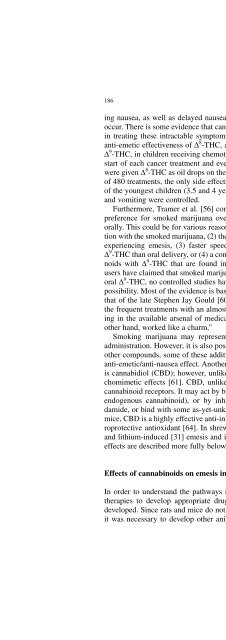3. Umbruch 4.4..2005 - Online Pot
3. Umbruch 4.4..2005 - Online Pot
3. Umbruch 4.4..2005 - Online Pot
Create successful ePaper yourself
Turn your PDF publications into a flip-book with our unique Google optimized e-Paper software.
186 L.A. Parker et al.<br />
ing nausea, as well as delayed nausea and vomiting and ANV when they do<br />
occur. There is some evidence that cannabis-based medicines may be effective<br />
in treating these intractable symptoms. Abrahamov et al. [59] evaluated the<br />
anti-emetic effectiveness of ∆ 8 -THC, a close but less psychoactive relative of<br />
∆ 9 -THC, in children receiving chemotherapy treatment. Two hours before the<br />
start of each cancer treatment and every 6 h thereafter for 24 h, the children<br />
were given ∆ 8 -THC as oil drops on the tongue or in a bite of food. After a total<br />
of 480 treatments, the only side effects reported were slight irritability in two<br />
of the youngest children (<strong>3.</strong>5 and 4 years old); both acute and delayed nausea<br />
and vomiting were controlled.<br />
Furthermore, Tramer et al. [56] conclude that many patients have a strong<br />
preference for smoked marijuana over the synthetic cannabinoids delivered<br />
orally. This could be for various reasons: (1) possible advantages of self-titration<br />
with the smoked marijuana, (2) the difficulty of swallowing the pills while<br />
experiencing emesis, (3) faster speed of onset for the inhaled or injected<br />
∆ 9 -THC than oral delivery, or (4) a combination of the action of other cannabinoids<br />
with ∆ 9 -THC that are found in marijuana. Although many marijuana<br />
users have claimed that smoked marijuana is a more effective anti-emetic than<br />
oral ∆ 9 -THC, no controlled studies have yet been published that evaluate this<br />
possibility. Most of the evidence is based upon anecdotal testimonials, such as<br />
that of the late Stephen Jay Gould [60]: “I was miserable and came to dread<br />
the frequent treatments with an almost perverse intensity. …Absolutely nothing<br />
in the available arsenal of medications worked at all. Marijuana, on the<br />
other hand, worked like a charm.”<br />
Smoking marijuana may represent a more efficient and rapid route of<br />
administration. However, it is also possible that as marijuana contains over 60<br />
other compounds, some of these additional consitutents may contribute to the<br />
anti-emetic/anti-nausea effect. Another major cannabinoid found in marijuana<br />
is cannabidiol (CBD); however, unlike ∆ 9 -THC, CBD does not produce psychomimetic<br />
effects [61]. CBD, unlike ∆ 9 -THC, does not bind to the known<br />
cannabinoid receptors. It may act by blocking the reuptake of anandamide (an<br />
endogenous cannabinoid), or by inhibiting enzymatic hydrolysis of anandamide,<br />
or bind with some as-yet-unknown cannabinoid receptor [61–63]. In<br />
mice, CBD is a highly effective anti-inflammatory agent [63], as well as a neuroprotective<br />
antioxidant [64]. In shrews, CBD inhibits cisplatin-induced [32]<br />
and lithium-induced [31] emesis and in rats CBD inhibits nausea [38]. These<br />
effects are described more fully below.<br />
Effects of cannabinoids on emesis in animals<br />
In order to understand the pathways involved in the response to anti-cancer<br />
therapies to develop appropriate drug therapies, animal models have been<br />
developed. Since rats and mice do not vomit in response to a toxin challenge,<br />
it was necessary to develop other animal models of emesis. As indicated in







